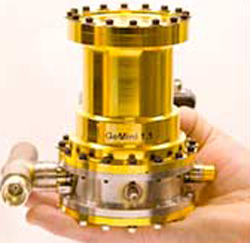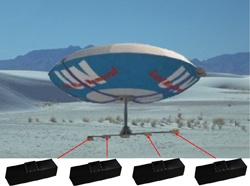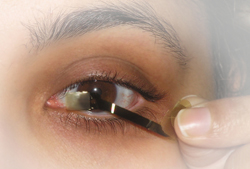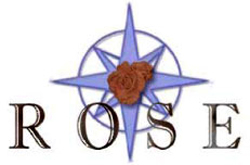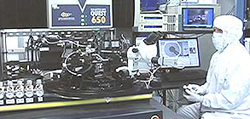LLNL projects earn eight 'Oscars of invention'
LLNL researchers have been honored with eight awards among the top 100 industrial innovations worldwide in 2008, representing advanced technologies with commercial potential.
These are the most awards the Laboratory has ever won in the annual R&D 100 competition. The previous LLNL record of seven awards was reached five times — in 1987, 1988, 1997, 1998 and 2006.
The eight technologies recognized by the trade journal R&D Magazine were developed by seven teams of LLNL scientists and engineers — and one solo LLNL researcher. They worked with six universities, six industrial firms, four other national labs, one medical institute, the U.S. Department of Energy (DOE), the Defense Threat Reduction Agency and the National Nuclear Security Administration (NNSA) Office of Dismantlement and Transparency.
The winning of an R&D 100 award, often dubbed the "Oscars of invention," provides a mark of excellence known to industry, government and academia and represents one of the most innovative ideas of the year.
This year's R&D 100 awards will be presented Nov. 12 during a black-tie dinner at the SeaWorld Conference Center in Orlando, Fla.
With this year's results, the Laboratory has now captured a total of 129 R&D 100 awards since 1978. DOE labs received a total of about 40 R&D 100 awards in this year's judging (some labs are joint winners on awards); of those, National Nuclear Security Administration (NNSA) projects received 18 awards.
Other DOE laboratories winning R&D 100 awards this year were: Oak Ridge National Laboratory, with eight awards, tying LLNL; Sandia National Laboratories, with five awards; Lawrence Berkeley, Los Alamos and Argonne national laboratories, each with four awards; the National Energy Technology Laboratory and Idaho National Laboratory, each with three awards; Pacific Northwest National Laboratory and the National Renewable Energy Laboratory, each with two awards; and Brookhaven National Laboratory, the Nevada Test Site and Ames Laboratory, all with one award each.
"I am extremely proud that the Laboratory technologies received eight prestigious R&D 100 awards and congratulate each of the researchers for this recognition of their groundbreaking scientific and technical work," Laboratory Director George Miller said.
"The number of awards and the diversity of applications are indicative of the innovative spirit of LLNL, our wide-ranging special capabilities, and our focus on tackling difficult technical challenges in the national interest."
Energy Secretary Steven Chu noted: "The Department of Energy's national laboratories are incubators of innovation, and I'm proud they are being recognized once again for their remarkable work. The cutting-edge research and development being done in our national labs is vital to maintaining America's competitive edge, increasing our nation's energy security, and protecting our environment. I want to thank this year's winners for their work and congratulate them on their awards."
This year's R&D 100 awards could prove helpful in homeland security, assist in locating land mines, improve sight for blind people and bolster fusion energy research, among other benefits.
Valued in space, on Earth
A team of LLNL scientists and engineers has developed GeMini, a portable gamma-ray spectrometer based on germanium technology. The instrument is so small that it fits in the palm of a hand, and this spectrometer is outfitted with an innovative low-powered, miniature cooling mechanism.
GeMini was launched on NASA's Mercury MESSENGER spacecraft and is now taking the first-ever gamma-ray data of the planet Mercury. GeMini also can be used to help prevent the smuggling of nuclear materials and can assist in the implementation of international safeguards for nuclear fuel cycles. This work was supported by the Defense Threat Reduction Agency and the NNSA Office of Dismantlement and Transparency to advance the Next Generation Safeguards Initiative.
Detecting land mines
The Land Mine Locator is a humanitarian aerial land mine detection system designed to lower the time and cost of demining operations, and vastly improve the safety to personnel and equipment. The locator is equipped with an array of ultra-wideband radar sensors and sophisticated subsurface tomography algorithms, both developed by LLNL, that provide exceptional quality subsurface images.
These technologies are combined with Hystar, a revolutionary aerial vehicle with unique flight capabilities that permit remote, reusable and safe operation for sensor platforms. This work is performed in collaboration with First Alliance Technologies LLC of San Ramon, Calif. and Hystar Aerospace Corp. of Vancouver, Canada.
Improving sight for the blind
LLNL is playing a lead role in the development of the first long-term retinal prosthesis – called an "artificial retina" — that can function for years inside the harsh biological environment of the eye. This work has been done in collaboration with four national laboratories (Argonne, Los Alamos, Oak Ridge and Sandia), four universities (the California Institute of Technology, the Doheny Eye Institute at USC, North Carolina State University and the University of California, Santa Cruz), an industrial partner (Second Sight® Medical Products Inc. of Sylmar, Calif.) and the Department of Energy.
With this device, application-specific integrated circuits transform digital images from a camera into electric signals in the eye that the brain uses to create a visual image. In clinical trials, patients with vision loss were able to successfully identify objects, increase mobility and detect movement using the "artificial retina."
Time microscope improves performance
LLNL researchers have developed the fiber-optic-based FemtoScope, a time microscope that can be attached to the front end of any conventional recording instrument, such as an oscilloscope or streak camera. The FemtoScope can dramatically improve the performance of these traditional recording devices in the same way a high-performance lens improves a camera's output.
When the FemtoScope is combined with an optical streak camera, the system achieves a 20-fold increase in temporal resolution simultaneous with a 30-fold improvement in dynamic range for an overall improvement of 600 times compared to the performance of the streak camera alone. This breakthrough offers the potential to yield important insights into understanding the process of fusion energy burn. This work was done in collaboration with Stanford University, the Optoelectronics Research Centre at the University of Southampton (Southampton, U.K.), and the University of California, Davis.
Protecting lasers from damage
Many of today's research lasers have multiple colors (bandwidth) added to their pulses to prevent laser damage. Damage occurs when seed pulses with incorrect bandwidth are amplified trillions of times, which can push laser materials beyond their physical limits.
Spectral Sentry is an advanced technology developed by LLNL scientists and engineers to protect critical laser systems from pulses that contain incorrect bandwidth for amplification. The device inspects each individual laser pulse, which is traveling at the speed of light (186,000 miles per second), and then determines if the pulse meets the bandwidth requirements to avoid self-destruction during amplification. Spectral Sentry can stop the same speed-of-light pulse it just measured from further amplification, thereby avoiding potential laser damage.
Making compiler technology more accessible
In computations, compilers are software applications, consisting of millions of lines of computer code that convert source code into binary code. Unfortunately, most compilers do not support source-to-source changes, so improvements to the source code can only be made manually.
ROSE, a compiler infrastructure developed by LLNL computer scientists, radically changes the accessibility of compiler technologies, allowing access to average software developers and scientists. ROSE enables users to build their own tools, including defect detection tools to uncover undetected bugs, code optimization tools to maximize program performance and program transformation tools that allow users to easily develop programs for today's fast changing hardware platform.
A precision robotic assembly machine
LLNL scientists and engineers have developed the precision robotic assembly machine to manufacture the small and complex laser-driven fusion ignition targets for the world's largest and most energetic laser, the National Ignition Facility.
The machine can manipulate millimeter-scale components with 100-nanometer precision in an operating arena the size of a sugar cube, and has a work volume the size of a shoe box. The machine can be used to build other complex miniature machines. This work was performed in collaboration with General Atomics of San Diego, Calif.; Indicate Technologies Inc. of Santa Clara, Calif.; and Aerotech Inc. of Pittsburgh, Penn.
Combining two laser alignment sensors into one
To ensure that a laser beam is properly aligned — and goes where it should — information is needed about two points along the beam. The first point, known as centering, determines if the beam is centered in its path, while the second, known as pointing, determines if the beam is going in the right direction to accurately hit the target.
A Lab physicist has developed the Laser Beam Centering and Pointing System. This system does the work of two sensors by using a special dual-imaging lens, which acts like a bifocal, to capture both images simultaneously and combine them into one. Because the system combines two alignment sensors into one, it cuts the cost of alignment components in half and saves space. It has no moving parts and provides huge advantages in stability and repeatability over conventional alignment systems.


